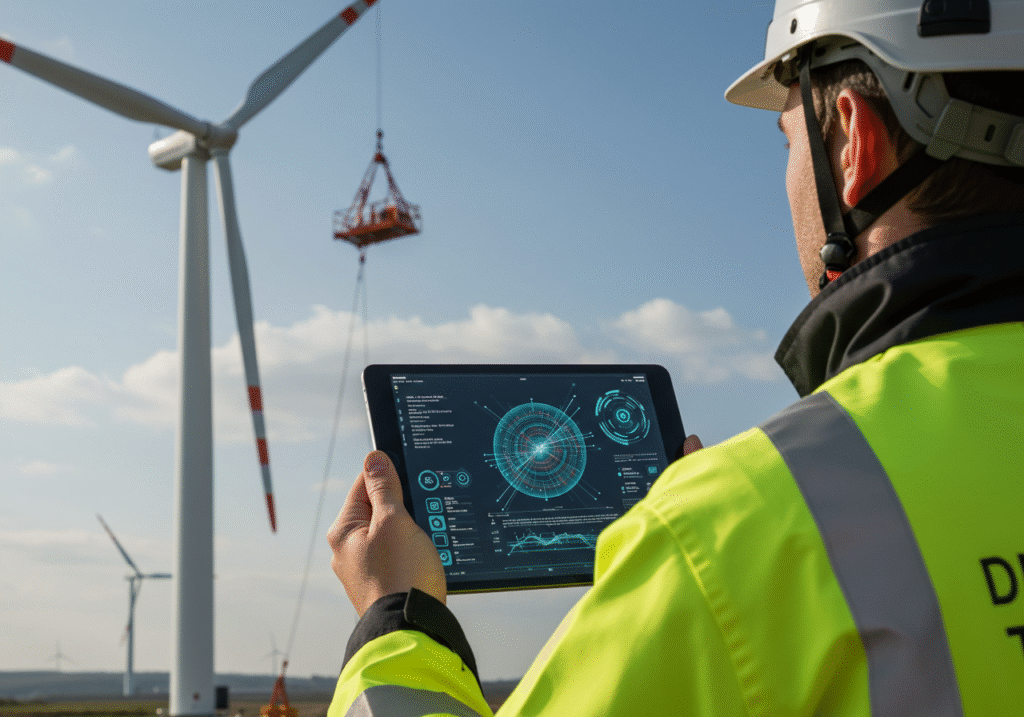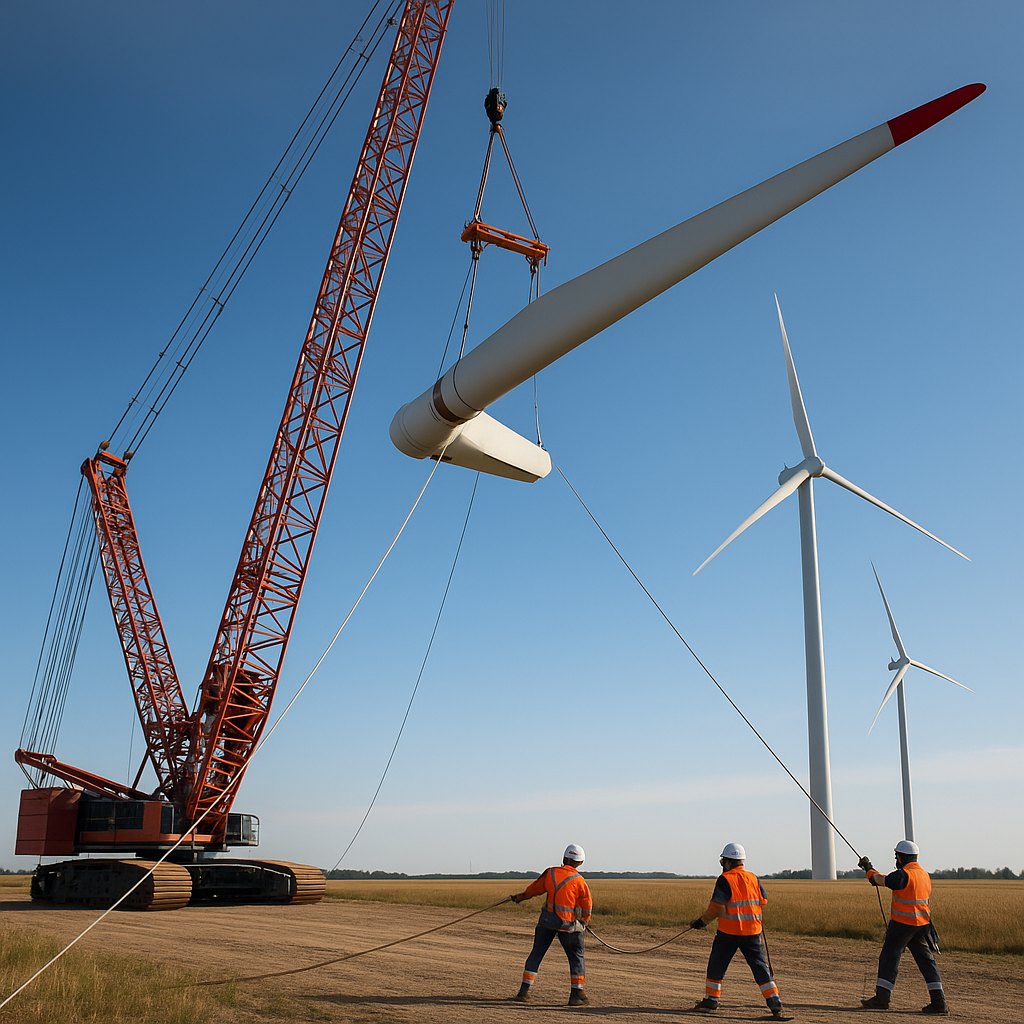
In the world of wind energy, few moments are as symbolic or as technically demanding as the blade lift. A single blade can stretch more than 80 meters, weigh several tons, and must be guided with absolute precision hundreds of feet into the air. The margin for error? Virtually zero.
At AFF Wind Services, we consider every blade lift not just a task but a signature moment, one that encapsulates our engineering rigor, safety commitment, team coordination, and technological discipline. From project kickoff to final tightening of bolts, our approach is rooted in operational excellence, shaped by deep industry knowledge, and delivered with consistency across diverse terrains and climates.
1. The Anatomy of a Blade Lift
Before a blade rises into the sky, there are weeks, sometimes months, of behind-the-scenes engineering work. From logistics and site prep to crane selection and weather monitoring, each decision influences the outcome.
Key Elements Involved:
- Blade Transportation & Storage: Specialized trailers, GPS-monitored routes, and wind-aware schedules.
- Crane Selection: Depending on turbine height and blade weight, we deploy cranes ranging from 500 to 750 tons, always inspected and optimized for site conditions.
- Ground Conditions: Soil load-bearing analysis, trackway installation, and gradient management.
- Team Roles: Lift director, riggers, signalers, and rotor technicians operate under coordinated protocols.
Each blade lift is a choreography of machines and minds, rehearsed meticulously and executed with surgical accuracy.
2. Engineering Meets Terrain: Adapting to Complex Landscapes
Whether in the rolling hills of Germany or the rugged fields of Lithuania, no two sites are alike. That’s why AFF Wind’s engineering team begins every project with a rigorous site assessment.
At the Akmene Project, for example, winter temperatures and soft ground conditions required us to reinforce crane pads with additional geogrids and modify the blade route with added turning clearances.
In southern Germany, steep access roads and fog-prone valleys meant we developed a phased lift schedule with morning-only lift windows and redundant communication lines between crane and crew.
Adaptation Is Our Advantage: What differentiates AFF Wind is not just our equipment but our ability to adjust lift strategy dynamically based on terrain, turbine design, and weather volatility.
3. Safety as a System: Culture, Checklists, and Contingency Plans
At AFF Wind, safety is not a department; it’s a culture. Our blade lift protocols follow a three-tier safety framework:
- Tier 1 – Personnel Readiness: All staff are certified (GWO, IRATA, HSE) and undergo daily toolbox talks.
- Tier 2 – Equipment Inspection: Pre-lift checklists cover crane alignment, tagline condition, bolt torque levels, and anti-collision systems.
- Tier 3 – Lift Simulation and Redundancy: Before every lift, we simulate scenarios using digital twin software and designate contingency teams.
In 2024 alone, AFF Wind completed over 250 blade lifts across 7 countries with zero major incidents, a reflection of our commitment to getting everyone home safe.

4. Technology That Elevates Execution
AFF Wind Services integrates cutting-edge digital tools to support blade lifting operations:
- Digital Twin Models for lift planning
- Real-Time Weather Stations for wind, gust, and shear monitoring
- Drone Surveillance to verify crane paths and clearance zones
- Sensor Tags on blades to monitor tilt and vibration during lift
These tools don’t replace experience—but they amplify it. With each project, our database of lift parameters grows, enabling data-driven improvements to safety and speed.
5. Teamwork in Action: The Human Chain Behind the Lift
A blade lift involves more than engineers and cranes. It’s a synchronized human chain:
- Planners define the lift sequence.
- Logistics teams ensure on-time component delivery.
- Technicians and riggers handle physical lift execution.
- Site managers and safety officers coordinate the entire operation.
What binds them all is a shared commitment to precision. At the Akmene site, for example, our team managed to lift all three blades of a turbine within 48 hours, beating the project schedule by 3 days all while complying with strict safety and weather constraints.
6. From Lift to Life: Commissioning and Quality Assurance
Once blades are lifted and fixed, our job doesn’t stop. We ensure each turbine is ready to go live through:
- Torque and tension verification
- Visual and ultrasonic blade inspections
- Yaw and pitch calibration
- Final QA checks aligned with OEM and client specs
This phase often determines long-term turbine performance. AFF Wind’s post-lift QA has helped reduce blade-related warranty claims for our clients by over 40%.
8. The AFF Wind Advantage
- ✅ Over 600 successful blade lifts since 2019
- ✅ Field teams certified across 8 countries
- ✅ 0 major lift incidents in 5 years
- ✅ Trusted by Vestas, Siemens Gamesa, Nordex, and Enercon
We don’t just lift blades;we lift project outcomes.
Whether you’re planning a new wind farm or retrofitting an aging turbine, AFF Wind brings engineering precision in motion. Because in the wind industry, every lift is a legacy.
Ready to elevate your next project?
📩 Contact: info@aff-windservices.com | 📞 +351 915 569 722
Follow AFF Wind Services for more insights from the field.
